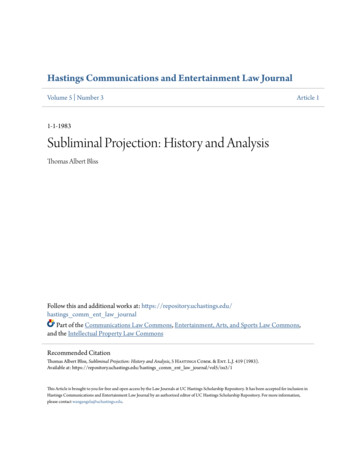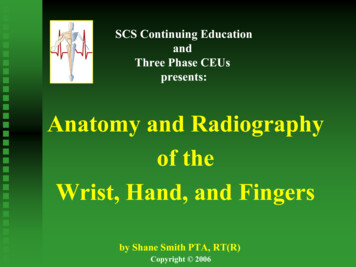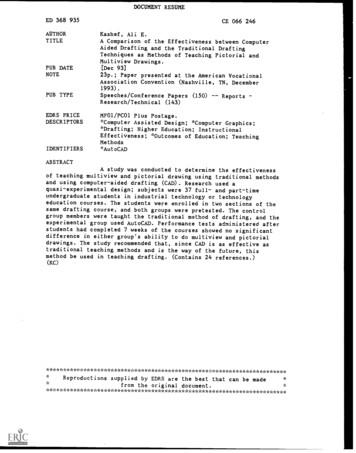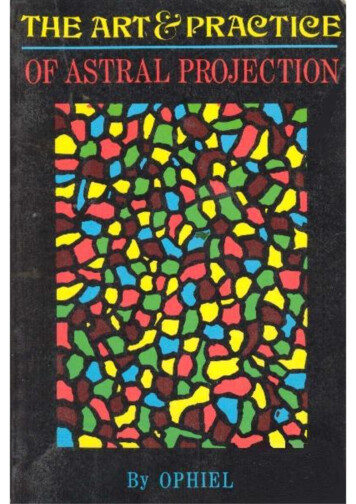
Transcription
Hastings Communications and Entertainment Law JournalVolume 5 Number 3Article 11-1-1983Subliminal Projection: History and AnalysisThomas Albert BlissFollow this and additional works at: https://repository.uchastings.edu/hastings comm ent law journalPart of the Communications Law Commons, Entertainment, Arts, and Sports Law Commons,and the Intellectual Property Law CommonsRecommended CitationThomas Albert Bliss, Subliminal Projection: History and Analysis, 5 Hastings Comm. & Ent. L.J. 419 (1983).Available at: https://repository.uchastings.edu/hastings comm ent law journal/vol5/iss3/1This Article is brought to you for free and open access by the Law Journals at UC Hastings Scholarship Repository. It has been accepted for inclusion inHastings Communications and Entertainment Law Journal by an authorized editor of UC Hastings Scholarship Repository. For more information,please contact wangangela@uchastings.edu.
Subliminal Projection: History andAnalysis*By THOMAS ALBERT BLISS**IIntroductionAll media have great potential to create and reinforce valuesand opinions of the recipient. Such persuasion may take placeconsciously or unconsciously. A current example of consciousor supraliminal value creation/reinforcement is the Sergio Valente designer blue jeans advertising campaign. Like countless clothing, automobile and other advertising campaigns, theSergio Valente advertisements demonstrate that a welldressed man, or in the case of the automobile advertisement,one who drives a "sexy" car, will turn the heads of admiringpotential sex partners. This conscious appeal to human needshas been well documented.'Human behavior can also be manipulated by the unconscious reception of information. When information ispresented or projected below the threshold of an audience'sconscious awareness, the information is said to be presentedor projected subliminally. The process whereby stimuli aresubconsciously received is known as subception.Subliminal projection in the print medium has been thorCopyright 1983 Thomas Albert Bliss. All rights reserved.A.B., J.D., University of California, Los Angeles, 1975, 1982. Member, DirectorsGuild of America.1. The eight hidden needs are:1. Emotional Security2. Reassurance of Worth3. Ego Gratification4. Creative Outlets5. Love Objects6. Sense of Power7. Sense of Roots8. ImmortalityV. PACKARD, THE HIDDEN PERSUADERS (1957); and Jef I. Richards and Richard D. Zakia,Pictures: An Advertiser's Expressway Through FTC Regulation, 16 GA. L REv. 77(1981).
COMM/ENTL. J.[Vol. 5oughly documented.2 Wilson Bryan Key, the best known theorist in this field, finds that such information is usually directedat the two basic human needs: sex and death, which are alsothe bases of most insecurities.' The theory behind subliminalprojection is that by presenting advertisements containing hidden images which suggest sex or death, the unsuspecting audience will relate the product advertised to those needs orinsecurities. Later, when faced with a choice, or simply due toa newly constructed "need," the subject will unconsciouslychoose the product most closely associated with those strongest of emotional stimuli-sex and death. The images must behidden and the subject unsuspecting because "once the subliminal information becomes apparent to the conscious mind,the persuasive or manipulative potential in the data is destroyed."4 Conversely, the more deeply buried the stimuli, thegreater may be its effectiveness. Examples of subliminal projection in the print medium are,5 to name but a few, hiddenimages of sexual intercourse in ice cubes,6 the word "sex" embedded throughout each and every model's hairstyle7 and theword "cancer" hidden in a cigarette advertisement.8A complete discussion of supraliminal projection or subliminal projection in the print media is beyond the scope of thisarticle; however, what is discussed are the techniques of subliminal projection as applied to visual and aural media. Although mention will be made of techniques and incidents inthe theatrical exhibition of motion pictures, this article focuseson the application of subliminal projection techniques tobroadcast and cable media. The reason for this focus is theprevalence of television and radio in virtually every homethereby providing the potential for a greater manipulativethreat.If subliminal techniques are indeed effective, there exists agreat potential for abuse. Interference in the marketplacecould be effected by these persuasive techniques. Governments could use media to subliminally indoctrinate their citi2. See W.KEY, SUBLIMINAL SEDUCTION(1973); W.(1976); W. KEY, THE CLAM-PLATE ORGY (1980).3. W. KEY, SUBLIMINAL SEDUCTION at 29 (1973).4. Id. at 27.5. See also Richards & Zakia, supra note 1.6. W. KEY, THE CLAM-PLATE ORGY at 7 (1980).7. W. KEY, SUBLIMINAL SEDUCTION at 156 (1973).8. W. KEY, MEDIA SEXPLOITATION at 171 (1976).KEY, MEDIA SEXPLOITATION
No. 31SUBLIMINAL PROJECTIONzens in a manner favorable to their needs. More importantthan and implied by these abuses is the basic threat whichyields all others: the invasion of a place one otherwise assumes to be the single secure and inviolable realm of total privacy-the mind.IIMechanicsVery little legal literature has been written about subliminalprojection in visual and aural media. Indeed, few instances ofthe use of such techniques have been recorded, perhaps due tothe expense or impossibility of obtaining recorded film or tapecopies of the programming involved. In addition, visual andaural media are ephemeral; there is no time to dwell on theimages and examine them for hidden content.The methods by which information may be transmitted tothe subconscious fall into two main categories: subaudible andsubvisual. Subaudible transmission occurs when informationis transmitted at such a low volume relative to the volume ofthe conscious program that the recipient cannot consciouslyperceive it. There are two distinct techniques involved in subvisual transmission. One subvisual technique involves flashing the information for such a brief amount of time that it isconsciously invisible. The other subvisual technique involvesthe continual superimposition of the message onto the visibleprogramming at such a relatively low level of visual intensityvia a very faint light projection that it is not visible to the conscious mind.Whether such techniques are effective in shaping subjects'responses is disputed. The major problem in determining theeffect is the difficulty in isolating the stimuli which are responsible for the various responses elicited by informationpresented audio-visually. One problem is the fact that subjectshave been shown to have innately differing perceptual thresholds.9 Additional problems include determining the extent towhich a given subject is actually persuaded as opposed to having incorporated the subliminal information into his or her own9. See Bevan, Subliminal Stimulation: A Pervasive Problem for Psychology, 61PSYCHOLOGICAL BuLL. 81, 92 (1964), in which Bevan summarizes that "data supportsthe conclusion that subliminal perceptual effects are real effects, though so sensitive inproduction as not to be seriously considered as a technique to be exploited in the interest of consumer sales or other practical goals."
COMM/ENT L. J.[Vol. 5value system 10 and measuring the extent to which informationmay not be subthreshold at all but rather may be filtered outby the subject's perceptual defense system." Effective or not,the use of such techniques presents questions regarding invasion of privacy. 2 It is as if a billboard has appeared in one'sliving room, consciously unnoticed but nonetheless uninvited.IIIEmpirical EvidenceA.Experimental ApplicationsThere have been several experimental uses of subliminalprojection techniques. These uses have yielded mixed results.Perhaps the best known experiment involved the SubliminalProjection Company, Incorporated, which used a tachistoscope 13 that projected the messages "Hungry? Eat Popcorn"and "Drink Coca-Cola" during the presentation of the motionpicture "Picnic" on a theater screen in Fort Lee, New Jersey.In that experiment the sale of popcorn was reported to haveincreased fifty-eight percent and the sale of Coca-Cola eight4een percent.In another experiment, the British Broadcasting Corporation, in 1956, flashed a brief message during one of its televisionprograms. At the end of the program viewers were asked ifthey had noticed anything unusual. Two hundred viewers re-sponded, a small percentage of whom identified the exactmessage. 3 Of course, it is possible that those who recalled theexact message had lower thresholds of consciousness and thatthe messages were, for them, supraliminal.10. See Barthol, The Subliminal Rabbit, THE NATION, Nov. 15, 1958, at 357, in whichProfessor Barthol concludes that "[t]he evidence indicates that the most that subliminal stimulation can do is to affect [slightly] a mood and possibly an attitude. . . Occasionally, perhaps, it can even indicate an idea .[elven the most clearly-structuralstimuli are reinterpreted by us to fit in with our value systems."11. See generally Goldiamond, Indicators of Perception: L Subliminal Perception,Subception, UnconsciousPerception: An Analysis in Terms of PsychophysicalIndicator Methodology, 55 PSYCHOLOGICAL BULL. 373 (1958); and N. DIXON, SUBLIMINAL PERCEPTION: THE NATURE OF A CONTROVERSY(1971).12. See infra notes 33-48 and accompanying text.13. A tachistoscope is a film projector with a high shutter speed that flashesmessages every five seconds at 1/3000th of a second. Kehl, Sneaky Stimuli and How toResist Them, CHRISTIANITY TODAY, Jan. 31, 1975, at 9.14. Geller, Truth About Those Invisible Ads, SCIENCE DIGEST, Dec. 1957, at 17.15. NATIONAL ASSOCIATION OF BROADCASTERS, MEMO ON SUBLIMINAL ADVERTISINGat 2 (Nov. 5, 1957).
No. 31SUBLIMINAL PROJECTIONAdditional tests have been performed by various televisionstations. One local station in the United States is reported tohave broadcast a subliminal public service announcementwhich resulted in several telephone calls. 6 Another station,WTWO of Bangor, Maine, flashed, "if you have seen thismessage, write WTWO" every eleven seconds for 1/80th of asecond, on alternate days, over station promotional announcements. The station reported no attributable increase inWTWO's mail and terminated the experiment.17 On January19, 1958, an undisclosed subliminal message was flashed 352times, alternately for 1/5 and 1/2 of a second during a half-hourCanadian Broadcasting Corporation (CBC) Television Network program carried on twenty-seven Canadian stations. TheCBC reported inconclusive results from this experiment. 8 Finally, a major commercial testing research organization hasconducted experiments that showed increased subject recall ofsubliminally mentioned products.' 9B.Non-Experimental ApplicationsIn many instances, subliminal projection has been used in anon-experimental format. Indeed, it is possible that the following documented uses represent but a small fraction of the totalemployment of subliminal devices.In 1957 the Precon Process and Equipment Corporation ofNew Orleans produced two films, "My World Dies Screaming"and "A Date With Death," which were heavily saturated withsubliminal images. Neither of these films were ever publiclyreleased; however, it is not unlikely that motion picture director William Friedkin made use of them in the making of hisfilm "The Exorcist." One of the most dramatic visual subliminal devices used in that film is a cut in which the face of FatherKarras, with skin greasy white, mouth a blood red gash andface surrounded by a white shroud, appears as a full-screendeath mask apparition. 0 This cut, which appears numeroustimes throughout the film, lasts only two frames. At twentyfour frames per second, with intermittent black-outs of equallength to facilitate the positioning of the next frame into the16.17.18.19.Id.Subliminal Projection, FCC INFORMATION BuL., Nov. 1977, at 1.Id. at 2.Memo on Subliminal Advertising, supra note 15, at 2.20. W. KEY,MEDIA SEXPLO1TATION at 101 (1976).
COMM/ENTL. J.[Vol. 5film projection gate, and taking into consideration the persistence of an image upon the retina, two frames would be visiblefor a total of 1/12 of a second. Although sixty-six percent ofthose in a test audience did not consciously perceive the deathmask,2 ' these subliminal images very possibly contributed tothe tension of the film.In addition to other brief images such as the face of FatherKarras, inter-cut throughout the entire film is a distinct andcomplete scene of a fox being hunted and finally caught by apack of dogs.2 2 The scene is of such length that it would beclearly perceived and remembered, but for the fact that it isinterspersed throughout the length of the film just a fewframes at a time.Friedkin also employed subliminal auditory devices to buildtension in "The Exorcist." Among the many sounds hidden inthe auditory background of the film is the sound of an angryswarm of bees, the sound of terrified pigs being slaughteredand the sound of orgasmic vocalization.2 3 All these soundswere designed to heighten tension and conscious attention.There are other applications of subliminal projection in addition to heightening the dramatic tension of a motion picture.In Canada, Quebec radio station CIME-FM broadcast subliminal messages between 11:30 pm and midnight five times a week'"to help listeners relax after a long day of stress and tension. "24Anti-shoplifting messages have been embedded into department store Muzak. 25 In 1971, Inflight Motion Pictures, Incorporated, which has a monopoly on inflight motion pictures,announced in The New York Times that it would initiate thesale of subliminal advertisements6 to be embedded in the films2that the corporation distributes.A midwestern United States television station used subliminal projection in an attempt to find a mass-murderer. Thinkingthat the killer would be interested in the news of his deeds, thestation interspersed throughout the news accounts of themurders, at two to three frames per insert, the message "Contact the Chief." The hope was that the killer, who had been21.22.23.24.25.26.Id. at 102.Id. at 101.Id.Quebec Radio in Subliminal Text, BILTBOARD, Oct. 14, 1978, at 71.W. KEY, MEDIA SEXPLOrrATION 111 (1976).N.Y. Times, Dec. 8, 1971, at 108, col. 6.
No. 3]SUBLIMINAL PROJECTIONsending notes to the media and authorities but had laterstopped doing so, might reestablish contact upon receiving thesubliminal suggestion. Unfortunately, this attempt was not27successful.The only known commercial application of subliminal projection in the broadcast media occurred shortly before Christmas, 1973. Television stations WGN, Chicago, and WPIX, NewYork, at the very least, carried a commercial that was preparedby the advertising agency Prescott-Adams-Nolan of CanogaPark, California. The advertisement was to promote the sale ofa game called "Husker-Du." Four of the frames of the sixtysecond filmed commercial contained the words "Get It." Although the words were perceptible to a few,2 8 it was apparentthat the majority of viewers could not consciously perceivethem.IVThe LawA.Statutory LiabilitySince its public beginnings, subliminal projection has drawnthe attention of regulating bodies. On January 13, 1958, theFederal Communications Commission (FCC), certain members of Congress, and the news media witnessed a demonstration of subliminal projection by the Subliminal ProjectionCompany, Incorporated, in which messages were flashed for 1/20th of a second every five seconds during a screening of "TheGray Ghost." The company explained the various techniquesto the group and suggested that such communications couldnot influence, but could only remind.2 9 One month later, onFebruary 13, 1958, the Precon Process and Equipment Company of New Orleans, producer of the previously noted unreleased films "My World Dies Screaming" and "A Date WithDeath," demonstrated its process and equipment to the FCCand the National Association of Broadcasters (NAB). Subsequent to those demonstrations, on February 8, 1958,and March 12, 1958, Representatives Jim Wright and Craig Hos27. Washington Post, May 12, 1978, at A13.28. Letter from Wallace E. Johnson, Chief, FCC Broadcast Bureau, to SenatorHoward Metzenbaum (Dec. 30, 1974), (regarding an inquiry by a Miss Ruth Gonze).29. Subliminal Projection, supra note 17, at 7.30. Id.
COMM/ENT L. J.[Vol. 5mer introduced bills H.R. 10802 and 11363, "to make unlawfulthe use of subliminal advertising on television and [to prescribe] penalties." Hearings were never held on either bill.Representative Wright, a former advertising man, reintroducedhis bill on January 9, 1959. This bill, H.R. 1998, 3' like the others,was referred to but never reported out of committee. 32 To thepresent day, there is no law dealing with the issue of subliminally presented material.B.Tort LiabilityBecause statutory remedies for subliminal projection arelacking, it is necessary to construct a theory based on the mostappropriate form of tort liability in order to ensure that thereare at least some private remedies available. An examinationof common law reveals that invasion of privacy theoryis by Invasion of privacy is, according to Dean Prosser, the invasion of something secret, secluded or private pertaining to theplaintiff. Furthermore, "the thing into which there is intrusionor prying must be, and be entitled to be, private."3 4 The Restatement defines invasion of privacy as the "unreasonable intrusion upon the seclusion of another" and establishes liabilityon the basis that "one who intentionally intrudes, physically orotherwise, upon the solitude and seclusion of another or hisprivate affairs or concerns, is subject to liability to the other forinvasion of his privacy, if the intrusion would be highly offensive to a reasonable person."3 5Case law uniformly holds that an individual has a reasonable31. H.R. 10802, 85th Cong., 2d Sess. (1958); H.R. 11363, 85th Cong., 2d Sess. (1958);H.R. 1998, 86th Cong., 1st Sess. (1959).32. Subliminal Projection,supra note 17, at 8.33. The FTC has statutory jurisdiction over deceptive advertising. See FederalTrade Commission Act, § 5, 15 U.S.C.A. § 45 (West Supp. 1980); see infra notes 67-76and accompanying text. For cases relating to unfair competition, see Evenson v.Spaulding, 150 F. 517 (9th Cir. 1907); and Standard Oil Co. v. Doyle, 118 Ky. 662, 82 S.W.271 (1904) (regarding intimidation, harassment or annoyance of a competitor's customers). Finally, although nuisance law almost always applies to interference with realproperty rights, there is one case dealing with an alarming advertisement: Where afalse report about a child-stealer was circulated, the court held that "the publication ofan advertisement calculated to alarm the public mind unnecessarily, is a public nuisance, and is indictable as such." Commonwealth v. Cassidy, 6 Phila., Pa. 82, 82 (C.P.1865).34. W. PROSSER, HANDBOOK ON THE LAw OF TORTS at 808 (4th ed. 1971).35. RESTATEMENT (SECOND) OF TORTS § 652B (1977).
No. 3]SUBLIMINAL PROJECTIONexpectation of privacy when in his home.3 6 This expectation ofprivacy also extends to an individual's telephone conversations, into which eavesdropping and wiretapping have beenheld to be actionable wrongs. 7 These types of wrongs involveinvading the privacy of another in order to take something,that is, information. What of a situation where there is an invasive giving of something? Professors Fowling V. Harper andFleming James, Jr. include an "interest in avoiding seeing andhearing what other people do and say" in their definition of anindividual's "interest in seclusion."3 8 Indeed, case law supports this view; it has been held time and again that it is aninvasion of privacy to harass a debtor at work 39 or at home40 bytelephone.It is but a short step to find that subliminal projection is aninvasion of the unwitting recipient's privacy. First, the thinginto which subliminal projection pries is the mind, our mostprivate possession. It cannot reasonably be doubted that if anindividual's home, work and telephone lines are consideredprivate, then his mind is also private. Second, the intrusion isintentional because the subliminal information is purposefullyinserted into the film. Third, and finally, the intrusion is atleast as offensive as harassing telephone calls (where at leastthe victim knows he is getting the calls) and is at least as unreasonable as eavesdropping (where the victim's thoughts ifnot words, remain private). Invasion of privacy, therefore, encompasses subliminal projection.A defendant in an action for invasion of privacy based uponsubliminal projection would be expected to counter with a defense of implied consent, that the plaintiff voluntarily introduced the radio or television into his home and turned it on,thereby consenting to whatever the radio or television mighttransmit. This defense may be refuted. The eavesdroppingand wiretapping cases show that voluntary introduction of a36. Dietemann v. Time, Inc., 284 F. Supp. 925 (C.D. Cal. 1968).37. Katz v. United States, 389 U.S. 347 (1967). See Fowler v. Southern Bell Tel. &Tel. Co., 343 F.2d 150 (5th Cir., 1965); LeCrone v. Ohio Bell Tel. Co., 120 Ohio App. 129,201 N.E.2d 533 (1963); Pinkerton Nat'l Detective Agency v. Stevens, 108 Ga. App. 159,132 S.E.2d 119 (1963); Rhodes v. Graham 238 Ky. 225, 37 S.W.2d 46 (1931).38. F. HARPER & F. JAMES,1 THELAW OF TORTS 681 (1956).39. See Montgomery Ward v. Larragoite, 81 N.M. 383, 467 P.2d 399 (1970); Housh v.Peth, 165 Ohio St. 35, 133 N.E.2d 340, affd, 99 Ohio App. 485, 135 N.E.2d 440 (1956).40. See Carey v. Statewide Finance Co., 3 Conn. Cir. Ct. 716, 223 A.2d 405 (1966);Housh v. Peth, 165 Ohio St. 35, 133 N.E.2d 340, affd, 99 Ohio App. 485, 135 N.E.2d 440(1956).
COMM/ENTL. J.[Vol. 5telephone into an individual's home does not amount to an implied consent to have personal conversations monitored. 1Even where the defendant has a right to physically intrudeinto an individual's private domain, that right "does not authorize exercise of such rights in a violent or insulting manner, regardless of the rights of others."'Before the defendant in an action for invasion of privacywould need to raise a defense, the plaintiff must set out aprima facie case. As part of the prima facie case, the plaintiffhas the burden of proving that the defendant put the subliminal frames in the film, that the plaintiff viewed the film, and thedefendant's conduct was a "material element and a substantialfactor" in causing the plaintiff's injury.43 This burden may bedifficult to surmount because the subliminally projected material is below the plaintiff's threshold of conscious awareness.In the past, however, subliminal messages have actually beenperceived by the viewer," as a message which is subliminal forone person may not be subliminal for another. In addition,these messages can be detected by examining a film frame byframe.Once a prima facie case of invasion of privacy has beenmade, at least nominal damages will follow. 45 The plaintiff isnot required to plead or prove special damages.' "The factthat damages resulting from an invasion of the right of privacycannot be measured by a pecuniary standard is not a bar torecovery."47 Furthermore, malice is not necessary. The rightto privacy is "distinct in and of itself. '48 Finally, where theplaintiff can prove actual economic losses stemming from a41. See Fowler v. Southern Bel Tel. & Tel. Co., 343 F.2d 150 (5th Cir., 1965); LeCrone v. Ohio Bell Tel. Co., 201 N.E.2d 533, 120 Ohio App. 129 (1963); Pinkerton Nat'lDet. Agency v. Stevens, 108 Ga. App. 159, 132 S.E.2d 119 (1963); Rhodes v. Graham, 238Ky. 225, 37 S.W.2d 46 (1931).42. May v. Western Union Tel. Co., 72 S.E. 1059, 1060, 157N.C.416 (1911); and seeMontgomery Ward v. Larragoite, 81 N.M. 383, 467 P.2d 399 (1970); Housh v. Peth, 165Ohio St. 35, 133 N.E.2d 340, a.f'd, 99 Ohio App. 485, 135 N.E.2d 440 (1956); Carey v. Statewide Finance Co., 3 Conn. Cir. Ct. 716, 223 A.2d 405 (1966).43. W. PROSSER, HANDBOOK ON THE LAW OF TORTS at 240 (4th ed. 1971).44. See supra text accompanying notes 15, 16 and 27.45. See Fairfield v. American Photocopy Equipment Co., 138 Cal. App. 2d 82, 291P.2d 194 (1955); Reed v. Deal Detective Pub. Co., 63 Ariz. 294, 162 P.2d 133 (1945).46. Id.47. Fairfield v. American Photocopy Equipment Co., 138 Cal. App. 2d 82, 291 P.2d194 at 198 (1955); and see Rhodes v. Graham, 238 Ky. 225, 37 S.W.2d 46 (1931); Brents v.Morgan, 221 Ky. 765, 229 S.W. 967 (1927).48. The Supreme Court has ratified the states' rights to protect privacy in Cantrell
SUBLIMINAL PROJECTIONNo. 3]subliminal influencing of her choice of products, money damages might follow on that basis as well.VThe Federal Communications CommissionThe FCC first addressed subliminal projection in a public notice issued on November 27, 1957, entitled Use of "SubliminalPerception"Advertising by Television Stations."9 In this noticethe FCC described the process, expressed its opinion that subliminal projection was a "matter which vitally concerns thepublic interest," and proposed to study the issue and "takesuch action as may be warranted."5In response to a letter from Senator Charles Potter of Michigan, the FCC explained its basis for regulating subliminal techniques. 5 The Commission's licensing procedures make clearthat regulation of radio transmissions must be guided by public interest, convenience or necessity.2 Furthermore, the FCCsuggested that subliminal projection techniques might be subject to the Commission's rulemaking authority under Communications Act section 303 which authorizes the Commission tomake rules governing the nature of the service to be renderedby each station, 3 the type of apparatus to be used 4 and theauthorization of new and experimental use studies.5 5 In addition, section 4(i) of the Act gives the Commission broad authority to make rules and regulations in carrying out itsfunctions and the provisions of the Act.56The Commission, noting that censorship and content determination are not proper functions of the FCC, holds the position that "it does not appear to be certain that the regulation[of] subliminal material would necessarily constitute censorship." 7 Rather, such regulation may be legitimately foundedupon the federal statute which requires broadcasters to disv. Forest City Pub. Co., 419 U.S. 245 (1974). See also Cason v. Baskin, 155 Fla. 198, 20 So.2d 243 (1945).49. FCC, Public Notice, FCC 57-1289 (Nov. 27, 1957).50. Id.51. 16 Rad. Reg. (P & F) 714 (1958).52. Communications Act of 1934, 47 U.S.C.A. § 303 (West Supp. 1980).53. Id. at § 303(b).54.55.56.57.Id. at §Id. at §Id. at §16 Rad.303(e).303(g).151 et. seq.Reg. (P & F) 714 (1958).
COMM/ENT L.J.[Vol. 5close both a sponsor's name and the fact of sponsorship whena commercial announcement is being broadcast.5 8 The Commission has stated that this statute would "prohibit broadcasters from subjecting audiences to messages received fromundisclosed sources. 5 9 Violations of this "sponsorship identification rule" have in fact resulted in declaratory orders for thepayment of fines, known as forfeitures, by licensees.6" However, use of this statute to regulate subliminal material hasthree substantial drawbacks. The first is that the statute, title47 United States Code section 317, applies only to messages received from undisclosed sources. Thus, broadcasters may notwithout the requisite disclosure insert a subliminal ad for onesponsor into the ad of another sponsor, nor may they insertsuch an ad into news, entertainment or public affairs programming.6 1 However, nothing in section 317 prevents broadcastersfrom inserting subliminal material within an advertisementwhen the sponsor of both the subliminal and supraliminalmessages is one and the same, and that entity is clearly identified as the sponsor.Second, the scope of section 317 is clearly limited to materialbroadcast in exchange for consideration. Thus, section 317fails to prohibit the inclusion of subliminal matter in publicservice announcements or other unsponsored announcements.Third, non-licensee persons involved with the production ofadvertisements or sustaining programs might insert subliminalmessages into such advertisements or programs. While section 317 does not foreclose the possibility of sanctions againstthe advertising agency or the program producer responsiblefor the inclusion of the subliminal material, it is clear that theFCC is without statutory authority to enforce the section58. Communications Act of 1934, 47 U.S.C.A. § 317 (West Supp. 1980) states asfollows:All matter broadcast by any radio station for which money, service or anyother valuable consideration is directly or indirectly paid, or promised to orcharged or accepted by, the station so broadcasting, from any person, shall, atthe time the same is so broadcast, be announced as paid for or furnished, asthe case may be, by such person.59. 16 Rad. Reg. (P & F) 714 (1958).60. In re Liability of Lamar A. Newcomb, Licensee of Station WFAX, Falls Church,Va., for Forfeiture, 1 F.C.C.2d 1395 (1965); In the Matter of Glen Harmon Corp., Licensee of Radio Station KAW, Little Rock, Ark., 1 F.C.C.2d 1478 (1965); where licenseeswere fined 1000 and 350, respectively, for failing to identify programming sponsor.61. 47 C.F.R. §§ 73.1212, 76.221 (1980).
No. 31SUBLIMINAL PROJECTIONagainst anyone other than the broadcaster.2 Regulation of theadvertising agencies and the program producers appears to fallwithin the jurisdiction of the Federal Trade Commission, notthe FCC. Thus if subliminal matter is broadcast without theknowledge of the broadcaster, and the broadcaster is not somehow chargeable with such knowledge, the FCC is without a ba63sis under section 317 upon which to act.Although the Commission could propose a specific rule ore
If subliminal techniques are indeed effective, there exists a great potential for abuse. Interference in the marketplace could be effected by these persuasive techniques. Govern-ments could use media to subliminally indoctrinate their citi-2. See W. KEY, SUBLIMIN










